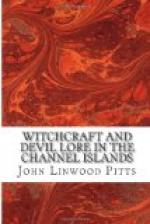* * * * *
While speaking of the burning of Witches in Guernsey, I may also refer for a moment to the three women who, in Queen Mary’s reign suffered death by fire, for heresy, because the reason of their condemnation and punishment has caused some controversy, and is often associated in the popular mind with a charge of sorcery. Dr. Heylin in his Survey (page 323), says:—
Katherine Gowches, a poor woman of St. Peter-Port, in Guernsey, was noted to be much absent from church, and her two daughters guilty of the same neglect. Upon this they were presented before James Amy, then dean of the island, who, finding in them that they held opinions contrary to those then allowed about the sacrament of the altar, pronounced them heretics, and condemned them to the fire. The poor women, on the other side, pleaded for themselves, that that doctrine had been taught them in the time of King Edward; but if the queen was otherwise disposed, they were content to be of her religion. This was fair but it would not serve; for by the dean they were delivered unto Helier Gosselin, then bailiff, and by him unto the fire, July 18, 1556. One of these daughters, Perotine Massey, she was called, was at that time great with child; her husband, who was a minister, having in those dangerous times fled the island; in the middle of the flames and anguish of her torments, her belly broke in sunder, and her child, a goodly boy, fell down into the fire, but was presently snatched up by one W. House, one of the by-standers. Upon the noise of this strange incident, the cruel bailiff returned command that the poor infant must be cast again into the flames, which was accordingly performed; and so that pretty babe was born a martyr, and added to the number of the holy innocents.
Parsons, the English Jesuit, has asserted that the women were felons and were executed for theft, while other apologists have described them as prostitutes and generally infamous in character. The original sentences, however, which still exist at the Guernsey Greffe, and which I have examined, conclusively settle the question. Both the ecclesiastical sentence, which is in Latin, and the civil sentence, which is in French, distinctly describe the charge as one of heresy, and make no mention whatever of any other crime as having aught to do with the condemnation.




